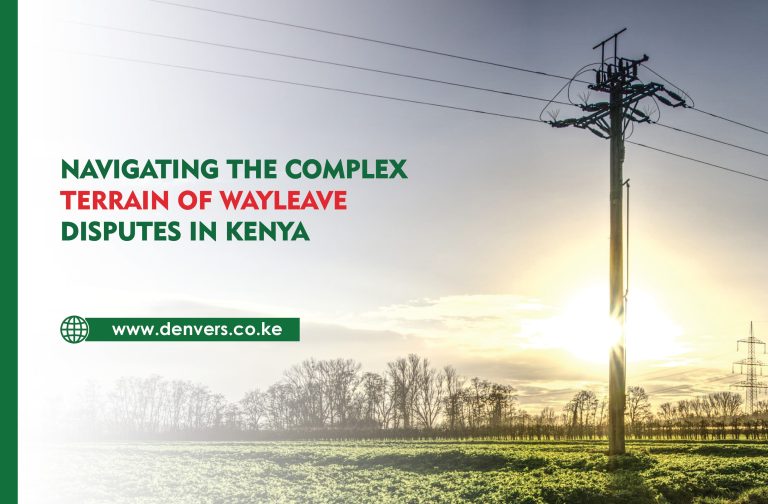Understanding Wayleaves in Kenya: A Guide to Rights-of-Way for Utilities
In Kenya’s ever-evolving infrastructure landscape, ensuring the smooth flow of electricity, water, and communication signals requires a crucial legal concept: wayleaves. A wayleave, in essence, grants a right-of-way over someone’s land to another party, typically a utility company, for installing and maintaining essential infrastructure. This comprehensive guide delves into the legalities and practicalities of wayleaves in Kenya, empowering landowners, developers, and utility companies to navigate these agreements effectively.
The Essence of Wayleaves: Securing Access for Utilities
A wayleave establishes a legal right for a utility company, such as Kenya Power or telecommunication providers, to install, maintain, repair, and replace their infrastructure on a specific portion of private land. This infrastructure could include:
- Power lines (overhead and underground)
- Water pipelines
- Sewerage lines
- Communication cables (fiber optic, copper)
The Legal Framework: Wayleave Act (Cap 292) and Energy Act (2006)

The primary legal framework governing wayleaves in Kenya is the Wayleave Act (Cap 292). This Act outlines the process for acquiring wayleaves, the rights and obligations of both landowners and utility companies, and dispute resolution mechanisms. Additionally, the Energy Act (2006) provides further regulations concerning wayleave acquisition for the electricity sector.
Types of Wayleaves in Kenya

There are two main types of wayleaves in Kenya:
-
Easement
This is a permanent right granted by the landowner to the utility company. Easements are typically registered on the land title deed, ensuring the right-of-way remains in place even if the land ownership changes. Easements are the preferred option for most utility companies due to their permanence.
-
Wayleave Consent
This is a temporary agreement between the landowner and the utility company. Wayleave consents are typically used for shorter-term projects or situations where a permanent easement is not necessary.
The Wayleave Acquisition Process in Kenya
The wayleave acquisition process typically involves the following steps:
-
Initiation by the Utility Company
The utility company identifies the land required for their infrastructure and initiates contact with the landowner.
-
Negotiation and Agreement
Both parties negotiate the terms of the wayleave agreement, including compensation for the landowner and any restrictions on land use.
-
Granting the Wayleave
Once an agreement is reached, the landowner grants the wayleave (either as an easement or a consent) through a legal document.
-
Compensation
The utility company compensates the landowner for the use of their land, as stipulated in the agreement. The amount of compensation can vary depending on factors like the size of the land affected, the type of infrastructure, and potential restrictions on land use.
Important Considerations for Wayleaves in Kenya

Understanding these key points is crucial for both landowners and utility companies:
-
Landowner Rights
Landowners have the right to negotiate the terms of the wayleave agreement, including compensation. They can also seek legal advice if necessary.
-
Compensation
Compensation should reflect the impact of the wayleave on the landowner’s property value and any restrictions on land use.
-
Dispute Resolution
If a dispute arises between the landowner and the utility company, there are mechanisms in place for mediation or arbitration.
-
Environmental Impact
The potential environmental impact of the wayleave should be considered and mitigated by the utility company.
The Benefits of Wayleaves
Wayleaves offer numerous benefits for Kenya’s development:
-
Efficient Infrastructure Development
Wayleaves ensure smooth and timely installation of essential utility infrastructure, fostering economic growth and improved living standards.
-
Fair Compensation for Landowners
Landowners receive compensation for the use of their land, providing an economic incentive for cooperation.
-
Clear Land Rights
Formalized wayleave agreements establish clear rights and obligations for both parties, reducing potential conflicts.
Challenges and Considerations for the Future
Despite the benefits, wayleaves in Kenya also face challenges:
-
Negotiation Delays
Negotiations between landowners and utility companies can be lengthy, potentially delaying infrastructure projects.
-
Compensation Disputes
Disagreements over the amount of compensation can arise, requiring mediation or arbitration.
-
Public Awareness
Landowners might not be fully aware of their rights and the wayleave process.
Conclusion: A Collaborative Approach for Sustainable Development
Wayleaves play a vital role in Kenya’s infrastructure development. By fostering open communication, fair compensation practices, and public awareness, a collaborative approach can ensure efficient infrastructure development while safeguarding the rights of landowners. As Kenya strives for sustainable growth, wayleaves will undoubtedly remain a crucial
Do you have questions about Wayleaves in Kenya or suggestions on the above and future topics?? We’d love to hear from you! Reach out to our property experts at [email protected] or call us on 0701730267.



